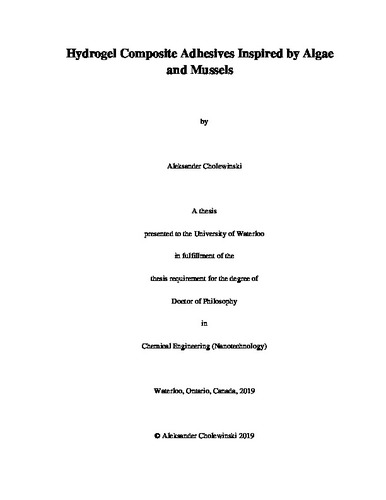UWSpace will be migrating to a new version of its software from July 29th to August 1st. UWSpace will be offline for all UW community members during this time.
Hydrogel Composite Adhesives Inspired by Algae and Mussels
| dc.contributor.author | Cholewinski, Aleksander | |
| dc.date.accessioned | 2019-09-25 16:28:58 (GMT) | |
| dc.date.available | 2019-09-25 16:28:58 (GMT) | |
| dc.date.issued | 2019-09-25 | |
| dc.date.submitted | 2019-09-03 | |
| dc.identifier.uri | http://hdl.handle.net/10012/15155 | |
| dc.description.abstract | The ocean is a vast source of a multitude of materials used in daily life, but has also provided numerous sources of inspiration for creating novel bio-inspired materials. Marine mussels are one of the best-known marine organisms that have inspired numerous underwater adhesives. These materials have found applications in a broad variety of fields; their usage in biomedical applications is the most prevalent, due to the abundance of wet environments within the body. However, many organisms that adhere to rocks and the sea floor have their own unique strategies for achieving adhesion in wet conditions. Many synthetic bio-inspired adhesives look purely to the chemistry of mussel adhesion for inspiration, while other facets of mussel adhesive strategies (such as process control) offer their own improvements. The objective of this dissertation is to develop and fabricate underwater adhesives that take inspiration from the adhesive chemistry and processes of both marine mussels and benthic algae. Algae and mussel systems were firstly combined by covalently modifying alginate polymer chains (extracted from brown algae) with catechol functionality (inspired by mussel chemistry). After ionic crosslinking, the resulting hydrogels were adhesive to soft and organic materials, showing promise adhesion to animal tissue samples. The effects of catechol functionalization on the mechanical properties of the gels were also investigated, and differences in adhesion between soft and rigid substrates was observed. Secondly, alginate and dopamine were combined together through noncovalent interactions; the ionic crosslinking of alginate and coordinate bonding of dopamine were exploited by using ferric ions to link the adhesive and cohesive components. By mimicking the processes of mussel and algae adhesion, a sequential application method was developed to improve adhesion of the algae-mussel-inspired glue, leading to adhesive strengths over 100 times that of pure alginate and over 5 times that of a non-sequential method. Finally, the stability and workability of the algae-mussel glue was improved by controlling dissolution and dispersion of the components. This was used to formulate both one-part and two-part adhesives that could be used hours or days after preparation, respectively, with the ability to be applied directly to objects underwater to bond them together. | en |
| dc.language.iso | en | en |
| dc.publisher | University of Waterloo | en |
| dc.subject | adhesives | en |
| dc.subject | hydrogels | en |
| dc.subject | bioinspired | en |
| dc.subject | dopamine | en |
| dc.title | Hydrogel Composite Adhesives Inspired by Algae and Mussels | en |
| dc.type | Doctoral Thesis | en |
| dc.pending | false | |
| uws-etd.degree.department | Chemical Engineering | en |
| uws-etd.degree.discipline | Chemical Engineering (Nanotechnology) | en |
| uws-etd.degree.grantor | University of Waterloo | en |
| uws-etd.degree | Doctor of Philosophy | en |
| uws.contributor.advisor | Zhao, Boxin | |
| uws.contributor.affiliation1 | Faculty of Engineering | en |
| uws.published.city | Waterloo | en |
| uws.published.country | Canada | en |
| uws.published.province | Ontario | en |
| uws.typeOfResource | Text | en |
| uws.peerReviewStatus | Unreviewed | en |
| uws.scholarLevel | Graduate | en |

